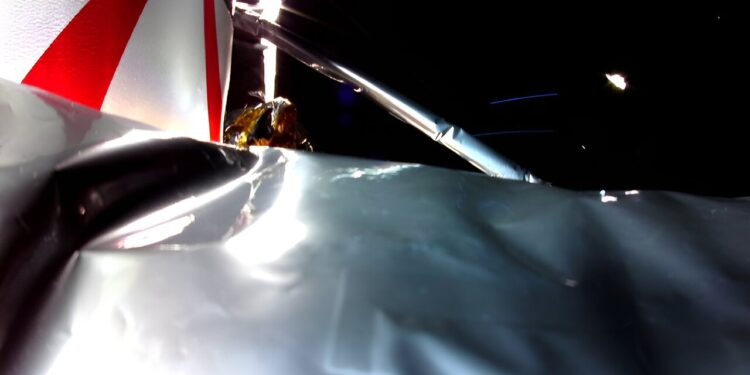This image released by Astrobotic on January 8, 2024 shows the first image of Astrobotic’s Peregrine lunar lander in space, with multi-layer insulation in the foreground.
A private U.S. lunar lander that lost fuel throughout its journey is now heading toward Earth and will likely burn up in the atmosphere, the company announced Saturday.
Astrobotic has been posting regular updates on the status of the Peregrine lander since the start of its ill-fated journey, which began when it blasted off on a brand new Vulcan rocket built by United Launch Alliance on January 8.
Shortly after separating from the rocket, the spacecraft suffered an onboard explosion and it soon became clear that it would not make a smooth landing on the Moon due to the amount of propellant it was losing – although the Astrobotic team was able to power the science experiments they were doing. carrying for NASA and other space agencies, and collecting spaceflight data.
“Our latest assessment now shows that the spacecraft is on a trajectory toward Earth, where it will likely burn up in Earth’s atmosphere,” the Pittsburgh-based company posted on X.
“The team is currently evaluating options and we will update as soon as we can.”
The box-shaped robot has now been in space for more than five days and is currently 242,000 miles (390,000 kilometers) from our planet, Astrobotic added.
Space observers have closely followed Peregrine’s trajectory and many hoped it might still make a “crash landing” on the Moon, as other failed landers have done before – although it is now clear that even this reduced objective will not be achieved.
In addition to scientific equipment, the spacecraft carries cargo for Astrobotic’s private clients, including a can of sports drink, physical Bitcoin, and human and animal ashes and DNA.
Astrobotic is the latest private entity to fail a soft landing, following an Israeli nonprofit and a Japanese company.
NASA had paid Astrobotic more than $100 million to transport its cargo, under an experimental program called Commercial Lunar Payload Services. The overall goal is to launch a commercial lunar economy and reduce its own overhead costs.
Even though it didn’t work this time, NASA officials have made it clear that their strategy of “more shots on goal” means more chances to score, and the next attempt, led by Intuitive Machines, based in Houston, will be launched in February.
Astrobotic itself will get another chance in November with its Griffin lander carrying NASA’s VIPER rover to the lunar south pole.
© 2024 AFP
Quote: Doomed US lunar lander now headed for Earth: business (January 14, 2024) retrieved January 15, 2024 from
This document is subject to copyright. Apart from fair use for private study or research purposes, no part may be reproduced without written permission. The content is provided for information only.



